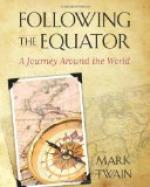In that garden I also saw the wild Australian dog—the dingo. He was a beautiful creature—shapely, graceful, a little wolfish in some of his aspects, but with a most friendly eye and sociable disposition. The dingo is not an importation; he was present in great force when the whites first came to the continent. It may be that he is the oldest dog in the universe; his origin, his descent, the place where his ancestors first appeared, are as unknown and as untraceable as are the camel’s. He is the most precious dog in the world, for he does not bark. But in an evil hour he got to raiding the sheep-runs to appease his hunger, and that sealed his doom. He is hunted, now, just as if he were a wolf. He has been sentenced to extermination, and the sentence will be carried out. This is all right, and not objectionable. The world was made for man—the white man.
South Australia is confusingly named. All of the colonies have a southern exposure except one—Queensland. Properly speaking, South Australia is middle Australia. It extends straight up through the center of the continent like the middle board in a center-table. It is 2,000 miles high, from south to north, and about a third as wide. A wee little spot down in its southeastern corner contains eight or nine-tenths of its population; the other one or two-tenths are elsewhere—as elsewhere as they could be in the United States with all the country between Denver and Chicago, and Canada and the Gulf of Mexico to scatter over. There is plenty of room.
A telegraph line stretches straight up north through that 2,000 miles of wilderness and desert from Adelaide to Port Darwin on the edge of the upper ocean. South Australia built the line; and did it in 1871-2 when her population numbered only 185,000. It was a great work; for there were no roads, no paths; 1,300 miles of the route had been traversed but once before by white men; provisions, wire, and poles had to be carried over immense stretches of desert; wells had to be dug along the route to supply the men and cattle with water.
A cable had been previously laid from Port Darwin to Java and thence to India, and there was telegraphic communication with England from India. And so, if Adelaide could make connection with Port Darwin it meant connection with the whole world. The enterprise succeeded. One could watch the London markets daily, now; the profit to the wool-growers of Australia was instant and enormous.
A telegram from Melbourne to San Francisco covers approximately 20,000 miles—the equivalent of five-sixths of the way around the globe. It has to halt along the way a good many times and be repeated; still, but little time is lost. These halts, and the distances between them, are here tabulated.—[From “Round the Empire.” (George R. Parkin), all but the last two.]
Miles.




